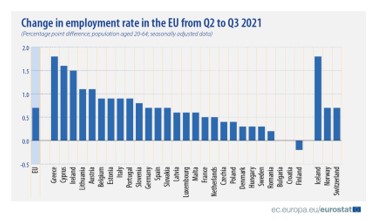Because employment in Europe is increasing, but not for women

Speech by Alessandra Servidori, professor of labor policies, member of the Steering Council for programmatic activity in the field of economic policy coordination at the presidency of the Council
In the EU, the employment rate of people aged 20 to 64 stood at 73.5% in the third quarter of 2021, which represents an increase of 0.7 percentage points compared to the second quarter of 2021.
The slowdown in the labor market, which includes all people who have an unmet need for employment and of which unemployment is a major component, amounted to 12.9% of the extended labor force aged 20-64. in the third quarter of 2021, down from 13.7% in the second quarter of 2021 (-0.8).

Labor market data in the third quarter of 2021 published by Eurostat specify that changes in the employment rate between the second and third quarters of 2021 varied between EU Member States. The highest increases were recorded in Greece (+1.8 pp), Cyprus (+1.6 pp), Ireland (+1.5 pp) as well as in Lithuania and Austria (both +1.1 pp). While employment increased in 24 EU Member States, it remained stable in Bulgaria and Croatia and decreased in Finland (-0.2 pp). In Italy, as can be seen from the diagram, Belgium, Estonia and Portugal are together at + 08, just above the average percentage.
In Italy, on the labor market side, according to Istat data, fixed-term employees are growing and exceeding three million: they are 3,003,000 in the third quarter of 2021 with an increase of 2.3% on the previous quarter and 13.1% % on the same quarter of 2020 and overall the employment rate 15-64 years, equal to 58.4%, has an increase in economic terms (+0.4 points in three months) which is associated with the decrease in the unemployment rate and than that of inactivity 15-64 years. We still have the provisional data for October 2021 which confirm the growth dynamics of the employment rate (+0.1 points compared to September), which is accompanied by the increase in the unemployment rate (+0.2 points) and the decrease in the inactivity rate (-0.2 points). The growth in the employment rate is also confirmed in trend terms (+1.7 points compared to the third quarter of 2021.
In a delicate period like the current one, both internally and internationally, in reference to the context of the world of work, it seems that at least for this year at the world level, unemployment will remain one of the major problems. In fact, as reported by the International Labor Organization, the initial forecasts of recovery during 2022 have been revised downwards. In short, it is necessary to wait until at least 2023 to return to the pre-pandemic numbers.
We focus our attention on distinguishing by sector and on the level of the gender gap. In fact, it is reported that the construction sector continues to grow; while in tourism the recovery is still partial and is held back by the new anti-contagion measures, which in fact have once again limited travel, movement and consumption.
In particular, in industry, the significant acceleration of construction has somehow compensated for the slowdown in manufacturing which, while not presenting significant employment losses, has not yet returned to the same growth path that it had, on average, in the two years before pandemic. And while taking note of the recovery in the spring and summer months, the margins for recovery in tourism are still wide. The latter is a sector that grew significantly before the health emergency resulting from the spread of the coronavirus. And if it is true that the recovery of the year just ended has favored male employment, which appears to be growing again as in the 2018-2019 two-year period, there is still ample room for recovery for female employment, whose trend showed signs of a certain weakness already in the pre-pandemic period.
In particular, the labor market situation indicates that female workers continue, according to the same admission of the Ministry of Labor, to “be penalized by a lower demand for permanent work. Although they represent about 42 per cent of the workforce, they account for only one third of the balance of permanent positions ". In terms of the objective gender gap between men and women, the monitoring studies on the labor market indicate that the already existing gaps have by no means been reabsorbed. And the unstable and uncertain period of the pandemic has certainly not helped and does not help overcome this difference. Female employment, which today in Italy is 50% against 65% of the EU average, is and remains an emergency and it is necessary to intervene immediately.
Today, many women stay at home to do free care and domestic work. It is necessary to take this work out of the house by expanding kindergartens, residences for the elderly but also services for the 'facilitation of daily life' (repairs, IT consultancy, handling of paperwork, home services of various kinds). And we're late.
This is a machine translation from Italian language of a post published on Start Magazine at the URL https://www.startmag.it/economia/occupazione-unione-europea-donne/ on Sat, 22 Jan 2022 06:53:20 +0000.
